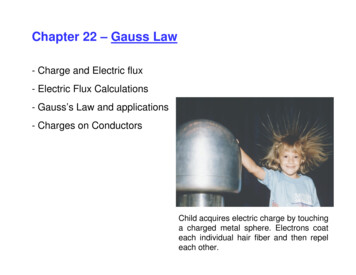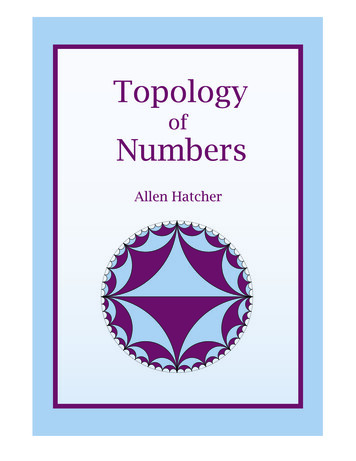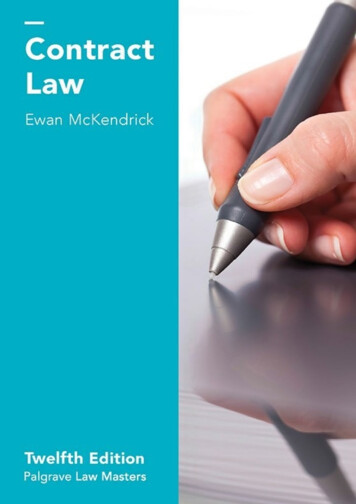
Transcription
Chapter 22 – Gauss Law- Charge and Electric flux- Electric Flux Calculations- Gauss’s Law and applications- Charges on ConductorsChild acquires electric charge by touchinga charged metal sphere. Electrons coateach individual hair fiber and then repeleach other.
1. Charge and Electric Flux- A charge distribution produces an electric field (E), and E exerts a forceon a test charge (q0). By moving q0 around a closed box that contains thecharge distribution and measuring F one can make a 3D map of E F/q0outside the box. From that map, we can obtain the value of q inside box.- If we construct a boundary around acharge, we can think of the flow coming outfrom the charge like water through a screensurrounding a sprinkler.
Electric Flux and Enclosed Charge:-There is a connection between sign of net charge enclosed by a closedsurface and the direction of electric flux through surface (inward for -q,outward for q).- There is a connection between magnitude of net enclosed charge andstrength of net “flow” of E.- The net electric flux through the surface of a box is directly proportional tothe magnitude of the net charge enclosed by the box.
2q 2Eq EE 1/r2r1 distance of q tosurface of box1.r2 2r1 distance of qto surface of box2.In (c), E2 E1/4, since r2 2r1, but A2 4A1 net flux constant.- Electric flux (perpendicular component of E) · (area of box face)-The net electric flux due to a point charge inside a box is independent ofbox’s size, only depends on net amount of charge enclosed.- Charges outside the surface do not give net electric flux through surface.
2. Calculating Electric FluxFlux Fluid Analogy:- If we considered flux through a rectangle,the flux will change as the rectanglechanges orientation to the flow.dV vAdt(v A)dV/dt volume flow ratev flow speeddV vA vA cos ϕ v A v Adt
Flux of a Uniform Electric Field: Φ E E A EA cos ϕ E AUnits: N m2/CΦE E·AWe can define a vector area:ΦE E·A·cosφ A A nˆFlux of a Non-uniform Electric Field:ΦE 0with n being a unit vector A.
3. Gauss’s Law- The total electric flux through any closed surface isproportional to the total electric charge inside thesurface.Point Charge Inside a Spherical Surface:qE 4πε 0 R 21ΦE E A E // dA at each pointqq24R π4πε 0 R 2ε01()- The flux is independent of the radius R of thesphere.
Point Charge Inside a Nonspherical Surface:- Divide irregular surface into dA elements, compute electric flux for each(E dA cosφ) and sum results by integrating.- Each dA projects onto a spherical surface element total electric fluxthrough irregular surface flux through sphere. qΦ E E dA ε0Integral through a closedsurfaceValid for / - qIf enclosed q 0 ΦE 0
Point charge outside a closed surface thatencloses no charge. If an electric field lineenters the surface at one point it must leave atanother.- Electric field lines can begin or end insidea region of space only when there is acharge in that region.General form of Gauss’s law: QΦ E E dA E cos ϕ dA E dA enclε0Example: Spherical Gaussian(negative inward flux)surfacearound–q q q q q2 πΦ E E dA dA dA 4r 2 4πε r 2 4πε r 2 ε000 4πε 0 r ()
4. Applications of Gauss’s Law- When excess charge (charges other than ions/e- making up a neutral conductor)is placed on a solid conductor and is at rest, it resides entirely on the surface, notin the interior of the material.- Electrostatic condition (charges at rest) E 0 inside material ofconductor, otherwise excess charges will move.E 0q 0
5. Charges on Conductors- Excess charge only on surface.- Cavity inside conductor with q 0 E 0inside conductor, net charge on surface ofcavity 0.- Cavity inside conductor with q E 0inside conductor, -q charge on surface ofcavity (drawn there by q). Total chargeinside conductor 0 q on outer surface(in addition to original qc).
Field at the surface of a conductor:Field outside a charged conductor isperpendicular to surface.σ q/A q σA
Ex. 22.2
1. Charge and Electric Flux - A charge distribution produces an electric field (E), and E exerts a force on a test charge (q 0).By moving q 0 around a closed box that contains the charge distribution and measuring F one can make a 3D map of E F/q 0 outside the box.











